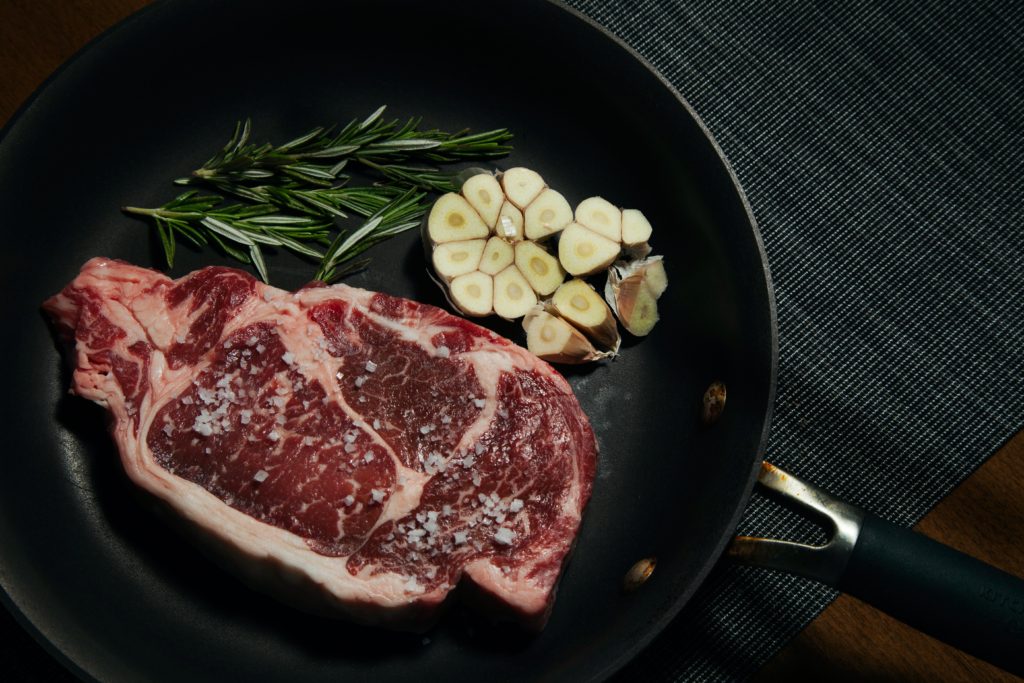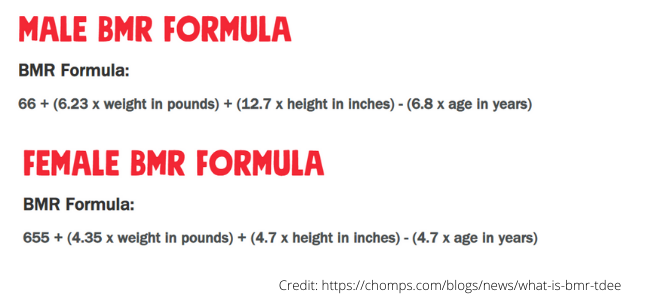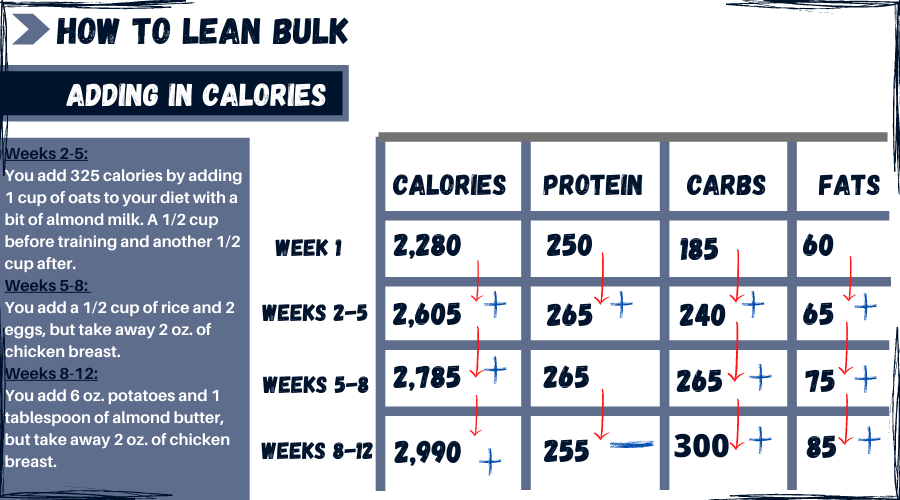How to Lean Bulk: Build Muscle While Staying Lean

Ditch the motto “eat big to get big.”
Yes, you must be in a calorie surplus to build a significant amount of muscle, but excessive overeating is not the most ideal way to build your physique.
“Eat just big enough to get big” should be the motto.
You’ve been in a calorie deficit for months, trimming away body fat to reveal the hard-earned muscle you’ve gained.
You’re down to 8% body fat and you’re ready to start increasing your calories.
Your primary goal is to build muscle, but you don’t want to get out of shape and sloppy.
Read that first part again.
Your primary goal is to build muscle. Not fat.
Does packing on new muscle tissue require more calories? Yup, sure does, but not as many calories as you’d think.
Will you gain body fat in the process of putting on muscle mass? Yup, you will. You cannot gain purely muscle mass, but this doesn’t mean you have to get sloppy.
You can’t force more muscle growth by eating more and more calories.
If that were the case, every single day would be an all-out eating contest.
At some point, the extra calories will just be stored as fat since only so many calories can be used to build muscle.
You will gain fat during a lean bulk, but by staying on top of your nutrition and being patient, you can minimize fat gain while building as much muscle as you can.
When you’re always relatively lean, you’re always within striking distance of single-digit body fat.
You don’t have to spend as much time in a calorie deficit getting rid of unwanted body fat.
You get to spend more time in a moderate calorie surplus, adding muscle.
Higher body fat is associated with poor insulin sensitivity, higher estrogen, and lower testosterone.
I’ll teach you how to lean bulk, successfully.
Everything you need to know, step-by-step.
Building muscle while staying lean is possible. It requires more work, patience, and attention to detail, but the final outcome is well worth it.
Table of Contents
- Find Your BMR, TDEE, and Calorie Requirements
- Determine Macronutrient Requirements
- Gradually Increase Calories
- Track Your Calories (And Macros If It Helps)
- Don’t Cheat Too Often
- Pay Attention to Your Physique
- Training To Build Muscle and Stay Lean
- Recovery
- Overview
Find Your BMR, TDEE, and Calorie Requirements
First, you’ll want to find out how many calories your body will need. When determining how many calories to eat, it’ll be helpful to know two things.
- BMR (Basal Metabolic Rate)
- TDEE (Total Daily Energy Expenditure)
BMR (Basal Metabolic Rate)
Your BMR is the number of calories your body needs at rest. Basically, the amount of calories your body needs to perform the most basic functions to keep you alive. This includes breathing, pumping blood throughout the body, blinking, cell production, etc.

Once you’ve found your BMR, you can use it to find your TDEE.
TDEE (Total Daily Energy Expenditure)
Your TDEE is an estimation of how many calories you’re burning each day including any exercise and physical activity. When using this formula, be honest with your activity level to get the most accurate TDEE.

Once you’ve found your TDEE, add 200-500 calories to that. That’s how much you should be eating daily for a lean bulk. Consuming 200 calories will have you gaining weight at a slower rate than consuming 500 calories would.
There are about 3,500 calories in a pound of fat, and roughly 2,500 to 2,800 excess calories are needed to build one pound of muscle.
No matter how high your calorie intake is, you can only gain so much muscle in a given time period.
You can’t gain a pound of muscle per day by eating an extra 2,500 calories per day. You’d gain a whole lot of fat.
Gaining a pound of muscle every month or two is much more realistic.
Calories do not reset at midnight each day and they do accumulate as the days and weeks go by.
Think of having an extra 2,500-2,800 calories accumulate over the course of a month.
Now, you might be thinking, “then why don’t I just eat an extra 85 calories per day and gain pure muscle and no fat?”
The math behind that question: 85 extra calories per day x 30 days in a month = 2,550 extra calories per month.
There are a few problems with that thought.
- Not every single extra calorie goes towards building muscle.
- You want to ensure you’re eating enough to build muscle with minimal fat gain. Eating too few extra calories per day would leave you too close to maintenance and you’d be progressing at an extremely slow rate.
- These equations aren’t perfect, but they give you a good estimate. Will eating an extra 3,500 calories result in exactly 1 pound of fat? No. Will eating exactly 2,500 extra calories result in 1 pound of muscle gained? Also no. There are so many factors involved that can affect these numbers. It will never be 100% accurate, but it’s certainly better than taking an uncalculated guess.
Find your BMR and TDEE. Then add 200 to 500 calories to your TDEE to get the amount of calories you should consume to build muscle while staying lean on your bulk.
Determine Macronutrient Requirements
Next, determining your macros.
For this example, let’s say this person weighs 200 pounds and is consuming 3,000 calories.
Protein intake should be at 0.8-1 gram per pound of body weight. For this example, we’ll use 1 gram per pound.
» If you weigh 200-pounds, you should be aiming for 200 grams of protein per day.
» There are 4 calories per gram of protein.
» 200 grams of protein x 4 calories per gram = 800 calories from protein.
» If you’re consuming 200 grams of protein, you’re getting in 800 calories from protein.
» 800 calories from protein divided by 3,000 total calories = 0.267 x 100 = 26.67 % of your diet is protein.
Carbohydrate intake can vary. It’ll typically land between 1.5-2 grams per pound of body weight.
Those who are sedentary outside of the gym may only need 1.5 grams.
If you’re very active and your body handles carbs very well, you may need up to 2 grams per pound, possibly more.
Also, some prefer to bulk on a moderate amount of carbohydrates, but higher fat.
Others prefer to bulk on higher carbohydrates, but less fat. Carbohydrates and fats usually have an inverse relationship, meaning the higher your carbs, the lower your fats. The lower your carbs, the higher your fats.
Instead of going by body weight, you can set your protein at 1 gram per pound, then your fats at 20-30% of your calories, and have the remainder of your calories come from carbohydrates.
» If you weigh 200-pounds, you should be aiming for 300-400 grams of carbohydrates per day. For this example, we’ll say this person is eating 350 grams.
» There are 4 calories per gram of carbohydrates.
» 350 grams of carbohydrates x 4 calories per gram = 1,400 calories from carbohydrates.
» If you’re consuming 350 grams of carbohydrates, you’re getting in 1,400 calories from carbohydrates.
» 1,400 calories from carbs divided by 3,000 total calories = 0.467 x 100 = 46.67 % of your diet from carbs.
Fat intake can also vary. It should be about 20-30% of your calories. This can vary depending on your carbohydrate intake. Remember, carbohydrates and fats typically have an inverse relationship. Higher carbs and lower fats. Or lower carbs and higher fats.
» 800 calories from protein + 1,400 calories from carbohydrates = 2,200 calories.
» So, you have 800 calories remaining to hit 3,000.
» There are 9 calories per gram of fat.
» 800 calories remaining divided by 9 calories per gram of fat = 88.89 grams of fat (we’ll round up and say 90 grams).
» 800 calories from fat divided by 3,000 total calories = 0.267 x 100 = 26.67 % of your calories from fat.
So, for this person weighing 200-pounds and eating 3,000 calories, their macronutrient breakdown would look like:
✓ Protein: 200 grams (27.67% of their calories are from protein).
✓ Carbohydrates: 350 grams (46.67% of their calories are from carbohydrates).
✓ Fats: 90 grams (26.67% of their calories are from carbohydrates).
26.67% + 46.67% + 26.67% = 100%
Keep in mind that these macronutrient percentages can vary by a good amount. This is just a good starting point. You can then adjust as needed based off how you feel, how you look, what works best for your body, recovery, and your performance in the gym.
You may see some great looking physiques that are have a breakdown of 30% protein, 45% carbs, and 25% fats.
Then another great looking physique that has a macronutrient breakdown of 25% protein, 55% carbs, and 20% fats.
Neither one is wrong. We are all different and each of us will have slightly different macronutrients needs.
Gradually Increase Calories
You’ve determined your BMR, TDEE, caloric intake, and macronutrient requirements. You’re now ready to execute the plan and start increasing your calories.
As mentioned earlier, there are about 3,500 calories in a pound of fat, and roughly 2,500 to 2,800 excess calories are needed to build one pound of muscle.
For a successful lean bulk, initially increase your calories by 200-500.
Obviously an extra 500 calories per day will have you gaining weight faster than an extra 200 calories per day.
For me personally, I rather start out on the low end at 200 calories and gradually work my way up, adding about 150 calories at a time as needed.
Initially, increase you calories by adding in primarily carbohydrates. As the weeks go on, continue to gradually add more calories from carbohydrates and fats.
Your protein intake can be reduced. This may sound backwards, but protein intake is typically higher during the fat loss phase.
Protein has a higher thermic effect of food, helps preserve muscle mass and strength, and keeps you full for longer between meals, making it the ideal macronutrient for fat loss.
When your focus is adding muscle, you don’t need as much protein, but you do still need at least 0.8 grams of protein per pound of body weight.
Keep in mind that the number of calories that will get you from 200-pounds to 205-pounds will most likely not be enough to get you from 205-pounds to 210-pounds.
As you gain weight, your caloric needs and macros will likely change.
Below is an example of how you could gradually increase your calories and adjust macros. This is not for the same example above with the 200-pound person eating 3,000 calories. These are made up numbers, and just an example to give you a basic idea.

Track Your Calories (And Macros If It Helps)
So you’ve determined your calorie and macronutrient needs and started to gradually increasing your calories to kick off the lean bulk.
Make sure you consistently and accurately track your calories to stay on top of your nutrition. When you know how much you’re eating and where those calories are coming from, it’s much easier to make the appropriate adjustments.
Use a food scale and nutrition label to accurately count calories and macronutrients. You can manually track you calories in your phone, or you can use an app like MyFitnessPal.
Tracking your calories and macronutrients allows you to closely monitor your nutrition. If you’re unfamiliar with serving sizes of the foods you’re eating, tracking macronutrients would be a good idea.
Prepare your meals, stick with a meal plan, and be consistent. Lean bulking requires more patience and attention to detail compared to a more relaxed approach, like a dirty bulk. The discipline and consistency that was required for attaining a single-digit body fat percentage will still be needed for a lean bulk, but to a lesser degree. I’d suggest still preparing your meals and being consistent.
Don’t Cheat Too Often
With the traditional massive bulks that put on dozens of pounds, cheat meals often become the norm. Bulking is commonly used as an excuse to make over the top cheat meals a regular occurrence.
Those excessive calories can add up quick, resulting in an unnecessary amount of weight gain.
Besides all the inessential calories, cheat meals usually consist of low-quality foods with little nutrients and high amounts of sugar and fat.
Muscle growth happens fastest when the body is being fueled by high-quality, nutrient-dense foods that provide your body with the building blocks it needs to recover and grow.
If you’re a very active person with an extremely fast metabolism, it might be a struggle to get in the calories from quality food. Cheat meals can come in handy in that case.
Cheat meals can also be a way to add more calories on days where you’re training a struggling muscle group. Or maybe you could use the extra food to fuel or recover from a very demanding, intense workout.
Cheat meals have their place and can be useful, but don’t overdo it.
Cheat meal frequency will vary from person to person. Factors like metabolism, hormones, insulin sensitivity, and activity level can affect how well your body handles cheat meals.
The size of your cheat meals matter too. On average, I’d suggest no more than 2 per week. Don’t go overboard.
Enjoy yourself, then get back on track.
Pay Attention To How Your Physique Is Changing
The scale
Regularly weigh yourself to make sure you aren’t gaining weight too fast or too slow. When weighing yourself, make sure all the conditions are the same. A convenient time would be first thing in the morning after going to the bathroom.
You can do it every Monday morning while you’re naked to take away the weight of clothing. In this case, the conditions will almost always be the same.
You won’t have any clothes on, you just went to the bathroom, and you haven’t eaten or drank anything in 8+ hours.
Pictures
You can also regularly take pictures every couple of weeks. We already see ourselves in the mirror nearly every single day. Seeing small, gradual changes can be hard to notice. The mirror is still a great way to monitor your physique changes, but pictures may be even better. Just like when weighing yourself, try to keep all the conditions the same for each progress picture.
How your clothes fit
Pay close attention to how your clothes fit you. Maybe you haven’t weighed yourself in a month, but noticed your clothes got noticeably tighter a lot quicker than you expected. You finally weigh yourself and realized you’ve gained 8 pounds in a month. That’s a little much for a lean bulk. Now you know it may be a good idea to lower you calories a bit.
Body measurements
Use a soft, flexible tape measure for body measurements. You can measure your shoulders, chest, arms, forearms, hips, waist, thighs, and calves. Do this once a month. Make sure you’re measuring before a workout, not after. Keep the tape tight so there’s no gaps between the tape and your body. This will help get a more accurate measurement. The tape should always be straight, not at an angle.
Be consistent with how you measure. Having someone else do your measurements will make it easier. To get a more accurate reading, you can do each body part 3 times and take the average of the 3. There’s plenty of room for human error during body measurements, so be careful.
Body composition tests
Body composition tests like hydrostatic weighing, DEXA scans, Bod Pod (air displacement), and bioelectrical impedance can be useful. You can also use skin calipers to determine your body fat percentage, but it won’t tell you your total body composition. DEXA scans are arguably the most accurate, with bioelectrical impedance being the least accurate. These can be done every 6-8 weeks.
Pay attention to how your physique is changing and make any changes to your nutrition if needed.

Training To Build Muscle and Stay Lean
Weight training
Follow a well-structured training program that is built around compound lifts with isolation exercises to complement them. Focus on progressive overload to force your muscles to adapt and your physique to change for the better.
Train at a high level of intensity, but train smart. Know when to go all-out, and when to pull back a bit. Fluctuating intensity and volume is important for avoiding injuries and burn out. Not every set needs to go to failure and not every workout needs to be at 100% intensity. A great training program follows these principles that allow you to sustain high levels of training intensity and make progress, but avoid injury and burnout
Cardio
Cardio is great to do year round for the health benefits. Some prefer to do some during their bulk, and some don’t. If you find yourself gaining weight a bit too fast, you can throw in cardio training to keep your weight and body fat under control instead of reducing your food intake. Start at just one or two days a week for 15-25 minutes, depending on intensity, and adjust as needed.
I’d limit cardio to no more than 4 days a week for 30 minutes at a moderate intensity, possibly 5 days if the intensity is pretty low. You don’t want cardio to interfere with your recovery or require you to eat more than your appetite allows.
Recovery
Rest days
I know, you’re always looking forward to training and it’s hard to take a day off from the gym, but learn to enjoy your rest days. They’re part of the program and are important for recovery and allowing you to sustain high levels of training intensity.
Without them, you’d be overly fatigued, your central nervous system would be fried, and muscles and joints will ache. I’d suggest taking 2-3 rest days a week.
Remember, in the gym you’re stimulating your muscles to grow. The actual muscle growth occurs outside the gym. Proper nutrition, rest, and recovery.
Sleep
Sleep is essential for your overall health and well-being, and building muscle. Without enough of it, your energy, mood, the quality of your workouts, and recovery can all be hampered.
Testosterone, growth hormone, and IGF-1 (Insulin-like Growth Factor) are all anabolic hormones get thrown off and are negatively impacted by poor sleep.
Cortisol, a catabolic stress hormone increases which can make building muscle more challenging than it already is. If you’re not sleeping well, it’s highly unlikely you’ll feel like hitting the gym. If you do, your workout will probably suck. If your workouts suck, your physique won’t change much.
Stretching
Many people dread stretching and fail to do it consistently, but it’s a simple way to take care of your body so you can perform better in the gym and build more muscle.
Stretching can allow you to perform exercises more effectively and with a full range of motion. It can help prevent injuries, aches, and pains.
When done after a workout or the day following a workout, it can help remove lactic acid build-up. This helps relieve soreness and speeds up recovery.
As you stretch, blood to the area being stretched increases. This increase in blood flow brings an increase in nutrients to feed the muscle and aid in recovery. I highly suggest combining stretching with foam rolling.
Foam Rolling (Self-Myofascial Release)
Another great way to take care of your body. Providing localized pressure to a muscle can relieve tightness, improve blood flow, and increase your range of motion.
You can use a foam roller, lacrosse ball, massage ball, massage gun, or a thick PVC pipe. I personally foam roll before a workout to get some blood flow to the muscle that’s about to be trained.
Another great time to foam roll is the day after training. As previously mentioned, foam rolling followed by stretching is a great combo.
Massages
Massages can be a great way to relax and basically do what foam rolling does, but to a greater extent since the massage therapist will likely apply more pressure than you can. Besides pressure, the massage therapist likely has some advanced techniques for relieving tension. If it fits your budget, schedule a massage once a week or every two weeks. If not, even once a month is better than nothing.

Wrapping Things Up
And there you have it. Lean bulking done right.
Just remember that you can not speed up muscle growth by simply eating in a larger surplus. You’ll end up gaining an unnecessary amount of body fat, which can then lead to physiological changes within your body that can actually make building muscle more of a challenge as your body fat
Train hard, train smart, and always strive to improve by applying the principle of progressive overload. Get enough sleep, take care of your body, and recover well. Track your progress and monitor your physique as it changes.
✓ Find your BMR and TDEE. Add 200-500 calories to your TDEE.
✓ Determine macronutrient breakdown.
✓ Get in at least 1 gram of protein per pound of body weight.
✓ Get in at least 1.5-2 grams of carbs per pound of body weight, some may need up to 2.5 grams per pound.
✓ About 20-30% of your diet should consist of healthy fats.
✓ There are about 3,500 calories in 1 pound of fat.
✓ Roughly 2,500-2,800 calories extra calories are needed to gain 1 pound of muscle.
✓ Gradually increase your calories after your fat loss phase
✓ Initially increase your calories by 200-500, then add another 100-150 at a time as needed.
✓ Track your calories, macros too if you’re very unfamiliar with portion sizes and the macros of the foods you’re eating.
✓ Don’t have cheat meals too often. Those calories can add up quick. You want quality, nutrient-dense foods most of the time.
✓ Pay attention to how your body is changing. Take different forms of measurements consistently under the same conditions.
✓ Train hard, train smart, focus on progressive overload and compound lifts.
✓ Sleep well, stretch, foam roll, and take care of your body. If you aren’t recovering, you aren’t building muscle.
If you could use some help building muscle while staying lean to build the physique you’ve always wanted, fill out the form below and I’ll get back to you as soon as I can!
